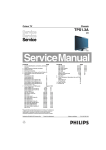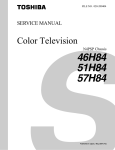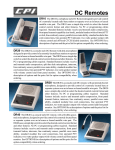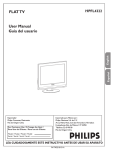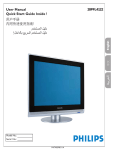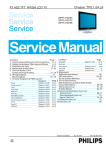Download Philips 15PFL4122/10 Specifications
Transcript
Colour Television Chassis TPS1.0E LA 15PFL4122/93 19PFL4322/93 20PFL4122/93 H_17090_000.eps 050607 Contents 1 2 3 4 5 6 7 Page Technical Specifications, Connections, and Chassis Overview 2 Safety Instructions, Warnings, and Notes 6 Directions for Use 8 Mechanical Instructions 10 Service Modes, Error Codes, and Fault Finding 12 Block Diagrams, Test Point Overview, and Waveforms Wiring Diagram 18 Block Diagrams 21 Circuit Diagrams and PWB Layouts Diagram Scaler Board: Power (S-01) 25 Scaler Board: Lips & Inverter I/F (S-02) 26 Scaler Board: Tuner (S-03) 27 Scaler Board: Video Inputs (S-04) 28 Scaler Board: DSUB Input (S-05) 29 Scaler Board: HDMI Input (S-06) 30 Scaler Board: SCART I/F (S-07) 31 Scaler Board: MST96885LD/ALD (S-08) 32 Scaler Board: Flash ROM & SDRAM (S-09) 33 Scaler Board: Key, IR BD & ComPair I/F (S-10) 34 Scaler Board: ITV I/F (S-11) 35 Scaler Board: Panel I/F (S-12) 36 Scaler Board: Audio I/F (S-13) 37 Scaler Board: Audio Amplifier (S-14) 38 Waveform Diagram 49 Inverter Board (IN) 51 Power Panel (For 19PFL4322) (P) 53 Power Panel (For 19PFL4322) (P) 54 Power Panel (For 20PFL4122) (P) 55 Power Panel (For 20PFL4122) (P) 56 Power Panel (For 20PFL4122) (P) 56 Data Transfer Board (For 20PFL4122) 61 Keyboard Panel (K) 63 Contents Page IR & LED Panel (I) 66 8 Alignments 69 9 Circuit Descriptions, Abbreviation List, and IC Data Sheets 75 Abbreviation List 79 IC Data Sheets 82 10 Recommended / Spare Parts List 86 Styling Sheet 86 Recommended Parts List 92 Spare Parts List 93 11 Different Parts List 112 12 Revision List 113 © Copyright 2007 Philips Consumer Electronics B.V. Eindhoven, The Netherlands. All rights reserved. No part of this publication may be reproduced, stored in a retrieval system or transmitted, in any form or by any means, electronic, mechanical, photocopying, or otherwise without the prior permission of Philips. Published by CS 0766 BG CD Customer Service Printed in the Netherlands Subject to modification EN 3122 785 17080 2 TPS 1.0E LA 1. Technical Specifications,Connections,and Chassis Overview 1.Technical Specifications,Connections,and Chassis Overview Index of this chapter: 1.1 Technical Specifications 1.2 Connections 1.3 Chassis Overview Notes: Figures below can deviate slightly from the actual situation, due to the different set executions. Specifications are indicative (subject to change) 1.1 Technical Specifications 1.1.1 Technical Specifications Panel Display area(mm) Number of Pixels Pitch ( mm ) Display operating mode Color depth Brightness (cd/m^2) Viewing angle(CR>10) Surface treatment Electrical interface Response Time Contrast ratio Outline Dimension Module weight (g) Backlight : LCD : 304.128(H) X 228.096(V) (15") 410.4 mm X 256.5 mm (19") 408 mm X 306 mm (20") : 1024(H) x 768(V) (15") 1440(H) x 900(V)(19") 640(H) x480(V) (20") : 0.29(H) x 0.29(V) (15") 0.285(H) x 0.285 mm(V) (19") 0.6375(H) x 0.6375(V) (20") : Normally black (15",20") Normally White (19") : 16.7M colors ( 8 bits) (15") 16.2M colors (19") 16.7M colors ( 8 bits) (20") : 250(Center 1 points, Typ.) (15") 300(Center 1 points, Typ.) Min : 230 (19") 450(Center 1 points, Typ.) (20") : Viewing angle free 70/70/70/60(R/L/U/D) (15") Viewing angle free (R/L 85/85 (Typ.) ,U/D 80/80(Typ.)) (19") Viewing angle free (R/L 178(Typ.) ,U/D 178(Typ.)) (20") : Hard coating 3H (15",19",20") : LVDS (15",19") TTL (20") : 8ms (Gray to Gray) (15") 5ms (Typ) (19") 12ms (Gray to Gray) (20") : Typical 700 : 1 (15") Typical 850 : 1 Min : 500 (19") Typical 800 : 1 (20") : 326.5 mm(H) x 253.5mm(V) x 14.4(D) mm (Typ.) (15") 427.2 mm(H) x 277.4 mm(V) x 17.0(D) mm (Typ.) (19") 432 mm(H) x 331.5mm(V) x 25.0(D) mm (Typ.) (20") : 1350(Typ.) (15") 2500g(Typ.) (19") 3500g(Typ.) (20") : 2 CCFL (15") 4 CCFL (19") 6 CCFL (20") User video timing specifications: Mode Resolution H. freq. / V. freq 1 640 x 350 31.469Khz/70.090Hz 2 720 x 400 31.469Khz/70.085Hz 3 640 x 480 35.000Khz/66.667Hz 4 640 x 480 37.861Khz/72.809Hz 5 640 x 480 37.500Khz/75.000Hz 6 800 x 600 35.200Khz/56.000Hz 7 800 x 600 48.077Khz/72.188Hz 8 800 x 600 46.875Khz/75.000Hz 9 832 x 624 49.700Khz/75.000Hz 10 1024 x 768 56.476Khz/70.069Hz TV system signal mode: RF support: WE: PAL B/G/D/K/I and SECAM L/L’/B/G /D/K . CVBS/S-video: Support PAL, NTSC and SECAM colour system. Comp video IN(YpbPr) : including 480i/p 50/60Hz,720p 50/60Hz, 1080i 50//59/60Hz,1080p 50//59/60Hz HDMI IN : 480p, 576p, 720p 50/60Hz, 1080i 50/59/60Hz, 1080p 50/59/60Hz For 19PFL4322/10 PC timing table Mode Resolution 1 640 x 480 2 800 x 600 3 800 x 600 4 1024 x 768 5 1280 x 720 6 1280 x 768 7 1360 x 768 8 1440 x 900 H. freq. / V. freq 31.469Khz/59.940Hz 35.156Khz/56.250Hz 37.879Khz/60.317Hz 48.363Khz/60.004Hz 44.772kHz/59.855 Hz 47.776kHz/59.87Hz 47.712kHz/60.015Hz 55.469kHz/59.901Hz Standard VGA VESA VESA VESA CVT CVT CVT CVT User video timing specifications: Mode Resolution H. freq. / V. freq 1 640 x 350 31.469Khz/70.087Hz 2 720 x 400 31.469Khz/70.087Hz 3 640 x 480 35.000Khz/66.667Hz 4 640 x 480 37.861Khz/72.809Hz 5 640 x 480 37.500Khz/75.000Hz 6 800 x 600 48.077Khz/72.188Hz 7 800 x 600 46.875Khz/75.000Hz 8 832 x 624 49.700Khz/75.000Hz 9 1024 x 768 56.476Khz/70.069Hz 10 1024 x 768 60.023Khz/75.029Hz Standard VGA VGA Macintosh VESA VESA VESA VESA Macintosh VESA VESA TV system signal mode: RF support: WE: PAL B/G/D/K/I and SECAM L/L'/B/G /D/K . CVBS/S-video: Support PAL, NTSC and SECAM colour system. Comp video IN(YpbPr) : including 480i/p 50/60Hz,720p 50/60Hz, 1080i 50//59/60Hz, 1080p 50//59/60Hz HDMI IN : 480p, 576p, 720p 50/60Hz, 1080i 50/59/60Hz, 1080p 50/59/60Hz Allowed signal mode specified For 20PFL4122/10 For 15PFL4122/10 PC timing table Mode Resolution 1 640 x 480 2 800 x 600 3 800 x 600 4 1024 x 768 5 1027 x 768 PC timing table Mode Resolution 1 640 x 480 2 720 x 400 H. freq. / V. freq 31.469Khz/59.940Hz 35.156Khz/56.250Hz 37.879Khz/60.317Hz 48.363Khz/60.004Hz 60.000Khz/75.000Hz Standard VGA VESA VESA VESA VESA Standard VGA VGA Macintosh VESA VESA VESA VESA VESA Macintosh VESA H. freq. / V. freq 31.469Khz/59.940Hz 30.240Khz/66.667Hz Standard VGA VGA TPS 1.0E LA 1. Technical Specifications, Connections and Chassis Overview TV WE model PRG 1 2 3 4 5 6 7 8 9 10 11 12 13 14 15 16 17 18 19 20 21 22 23 24 25 28 CH AU37 AU2 E7 G47 I23 E12 AU7 G68 AU9 AU10 AU0 AU2 AU5 AU5A AU7 AU9 AU10 I23 G28 AU37 I40 CH44 I60 I66 K21 G28 Frequency Carriers Video Sound 590.25MHz 595.75MHz 64.25MHz 69.75MHz 189.25MHz 194.75MHz 679.25MHz 684.75MHz 487.25MHz 493.75MHz 224.25MHz 229.75MHz 182.25MHz 187.75MHz 847.25MHz 852.75MHz 196.25MHz 201.75MHz 209.25 MHz 214.75 MHz 46.25MHz 51.75MHz 64.25MHz 69.75MHz 102.25 MHz 107.75 MHz 138.25MHz 143.75MHz 182.25MHz 187.75MHz 196.25MHz 201.75MHz 209.25MHz 214.75MHz 487.25MHz 493.75MHz 527.25MHz 532.75MHz 590.25MHz 595.75MHz 623.25MHz 629.75MHz 655.25MHz 661.75MHz 783.25MHz 789.75MHz 831.25MHz 837.75MHz 471.25 MHz 477.75 MHz 527.25MHz 532.75MHz TV System Pattern PAL B Pure White PAL B Circle Pattern PAL B Circle Pattern PAL G Circle Pattern PAL I Circle Pattern PAL B Color Bar PAL B Color Bar PAL G 100% White PAL B Checkerboard PAL B Crosshatch PAL B Color Bar PAL B Color Bar PAL B Crosshatch PAL B Color Bar PAL B Pure White PAL B Pure White PAL B Circle Pattern PAL I Circle Pattern PAL G Circle Pattern PAL G Circle Pattern PAL I Color Bar PAL DK Color Bar PAL I 100% White PAL I Checkerboard SEC K1 Crosshatch PAL G Color Bar Ambient conditions Temperature Humidity 3 : 0 to40°C : 10 to 90% 1.2 Connectors 1.2.1 I/O interface 1. Tuner: Multi-standard for WE model 2. Audio 1 IN : audio R/L(RCA jack) input 3. AV1 IN : Composite video input (CVBS) 4. S-video IN : S-video input 5. Comp video IN :YPbPr format input 6. AV2 IN: Composite video (CVBS) input 7. Audio 2 IN : Comp and AV2 audio R/L(RCA jack) input 8. Scart IN : YPbPr/CVBS with audio input and CVBS with audio line out 9. PC Audio IN: audio R/L(mini-jack). 10. PC IN: VGA input (D-SUB connectors) 11. HDMI : digital video and audio input 12. Earphone : earphone jack Comp video input mode: 480i, 480p, 576i, 576p, 720p50, 720p59, 720p60, 1080i50, 1080i59, 1080i60, 1080p50, 1080p59, 1080p60 HDMI input mode 1 720x480p/59Hz, 60Hz,720x576p/50Hz, 2 1280X720p, 50Hz , 59Hz, 60Hz 3 1920X1080i, 50Hz, 59Hz, 60Hz 4 1920X1080p, 50Hz, 59Hz, 60Hz 1.2.2 PC mode signal type a.Analog Video : 15 pin D-sub ,0.7 Vp-p linear, positive polarity & separate sync.( TTL level, positive or negative polarity) b.Audio signal 1.1.2 Sound Sound systems Maximum power : Mono / Stereo / Virtual Surround : 2 x 3W 1.1.3 Miscellaneous Power Supply AC-input : 90V ~ 264VAC, 50/60 2Hz (15",19") : 90V ~ 264VAC, 50/60 3Hz (20") Power consumption : 35W/Max(at PC mode),35W/Max(at TV mode) with Audio. (15") 70W/Max(at PC mode),70W/Max(at TV mode) with Audio. (19") Normal: (20") 1. PC Mode: TYP 60 W (with audio) 2. TV Mode: TYP 60 W (with audio) Maximum: 65W (with audio) (20") Power cord length 1.8m Power cord type : European type and China type (15",19") 3 lead with earth plug, pluggable (20") Power indicator : LED (On: Blue ,Sleeping mode: Red ) (15") LED (On: Blue ,Sleeping mode: Amber ) (19") LED (On: Blue, Standby mode: Amber) (20") Auto power saving : < 2W (15",19") VESA DPMS (20") : 3.5mm stereo mini-jack Level: Nominal : 0.5 V rms. - Maximum : 1.5 V rms. -Impedance > 10 kW. c.Signal source: Pattern generator format as attachment table 1 to 12. Reference generator : CHROMA 2200 or QuantumData 802R TV mode signal type RF Signal : Aerial input / 10mV(30-100dBuV) Video signal : CVBS input ( RCA jack) / 1Vpp (300mV-sync, 700mV-video.) S video input / 1VppY-signal, +/-300mV C-signal SCART input: CVBS YPbPr signal ( for WE model only) Comp video in(YPbPr input)/ 1Vpp Y signal, +/-350mV Pb,Pr signal HDMI:Digital interface with 4 channels TMDS signal CVBS output ( SCART line out) / 1Vpp (300mV-sync, 700mV-video.) Audio signal : Audio (1) R/L for AV IN(AV and S-Video). Level: - Nominal : 0.5 V rms. - Maximum : 1.5 V rms. - Impedance > 10 kW. Audio (2) R/L for SCART IN Level: - Nominal : 0.5 V rms. - Maximum : 1.5 V rms. - Impedance > 10 k W. Audio (3) R/L for Comp video IN. Level: - Nominal : 0.5 V rms. -Maximum : 1.5 V rms. -Impedance > 10 k W. 4 TPS 1.0E LA Audio 1. Technical Specifications,Connections,and Chassis Overview (4) digital audio for HDMI Video IN. 1.2.5 Scart Scart output: ( for WE model only) Video: CVBS output 1Vpp / Impedance : 75W. Audio: R/L output (from CVBS) Level: - Nominal : 0.5 V rms. - Maximum : 1.5 V rms. - Impedance < 1 k W. Headphone Audio: R/L output -10mW at 32W. 3.5mm stereo jack with switch Impedance is between 8 and 600 W. 1.2.3 VGA Pin assignment Pin 1 2 3 4 5 6 7 8 PIN No. 1 2 3 4 5 6 7 8 9 10 11 12 13 14 15 SIGNAL Red video input Green video input /SOG Blue video input GND GND– cable detect Red video ground Green video ground Blue video ground DDC +3.3V (or 5V) Logic ground GND Serial data line (SDA) H. Sync / H+V V. Sync Data clock line (SCL) 1.2.4 HDMI Pin assignment Type A Connector No. 1 No. 2 Pin No. 1 2 3 4 5 6 7 8 9 10 11 12 13 14 15 16 17 18 19 No. 19 No. 18 Description RX2+ GND RX2RX1+ GND RX1RX0+ GND RX0RXC+ GND RXCCEC NC DDC clock DDC data GND +5V POWER Hot Plug Detect 9 10 11 12 13 14 15 16 17 18 19 20 21 TV SCART N/C Right audio input N/C Audio ground Blue ground Left audio input Blue output 0-2.5 volts (low) when: TV output 4.5-7.5 volts (High-to-6v) when: -inputting picture format setting is '16:9', 9-12 volts (high-to-12v) when: -inputing picture format setting is '4:3' Green ground N/C Green output N/C Red ground N/C Red output 0 volt (low) when:- pin 8 of the TV scart is low or when: - Composite video signal 1-3 volts (high) when: - video input setting is 'RGB', Composite video output ground Composite video input ground N/C Composite video input Ground 1. Technical Specifications, Connections and Chassis Overview TPS 1.0E LA 1.3 Chassis Overview Type: 15PFL4122/10 Key Board IN Inverter Board I Scaler Board K S IR Board Type: 19PFL4322/10 Key Board P Power Board I IR Board Scaler Board K S Type: 20PFL4122/10 P I Key Board K Scaler Board S Power Board IR Board 5 6 TPS 1.0E LA 2.Safety Instructions,Warnings,and Notes 2.Safety Instructions,Warnings,and Notes · Where necessary,measure the waveforms and voltages with( ) and without( )aerial signal.Measure the voltages in the power supply section both in normal operation( ) and in stand-by( ). These values are indicated by means of the approprate symbols. Index of this chapter: 2.1 Safety instructions 2.2 Warnings 2.3 Notes · The semiconductors indicated in the circuit diagram and in the parts lists,are interchangeable per position with the semiconductors in the unit,irrespective of the type indication on these semiconductors. · Manufactured under license from Dolby Laboratories. "Dolby ", "Pro Logic" and the "double-D symbol",are trademarks of Dolby laboratories. 2.1 Safety Instructions Safety regulations require the following during a repair: · Connect set to the Mains/AC Power via an isolation transformer(>800VA) · Replace safety components,indicated by the symbol ! , only by components identical to the original ones.Any other component substitution(other than original type)may increase risk of fire or electrical shock hazard 2.3.2 Schematic Notes · All resistor values are ohms,and the value multiplier is often used to indicate the decimal point location(e.g. 2K2 indicates 2.2 kohm). · Resistor values with no munltiplier may be indicated with either an "E" or an "R"(e.g.220E or 220R indicates 220 ohm). · All capacitor values are given in micro-farads(u=x10-6),nanofarads9n=x10 -9 ),or pico-farads(p=x10 -12). · Capacitor values may also use the value multiplier as the decimal point indication(e.g. 2p2 indicates 2.2 pF). · An "asterisk"(*) indicates component usage varies.Refer to the diversity tables for the correct values. · The correct component values are listed in the Spare Parts List. Therefore,always check this list when there is amy doubt. Safety regulations require that after a repair,the set must be returned in its original condition.pay in particular attention to the following points: · Route the wire trees correctly and fix them with the mounted cable clamps. · Check the insulation of the Mains/AC power lead for external damage. · Check the strain relief of the Main/AC power cord for proper function. · Check the electrical DC resistance between the pins of the Mains/AC Power plug and secondary side(only for sets that have a Mains/AC power isolated poer supply): 1. Unplug the Mains/AC Power cord and connect a wire between the two pins of the Mains/AC power plug.\ 2.Set the Mains/AC Power switch to the "ON " position (keep the Mains/AC Power cord unplugged!) 3.Measure the resistance value between the pins of the Mains/AC Power plug and the metal shielding of the tuner or the aerial connection on the set.The reading should be between 4.5 Mohm and 12 Mohm. 4.Switch "OFF" the set,and remove the wire between the two pins of the Mains/AC plug. 2.3.3 Lead-free Solder Philips CE is producing Lead-free sets (PBF) from 1.1.2005 onwards. Idntification:The bottom line of a type gives a 14-digit serial number.Digial 5 and 6 refer to the production year,digits 7 and 8 refer to production week( inexample below it is 2007 week14) · Check the cabinet for defects,to prevent touching of any inner parts by the customer. 2.2 Warnings MODEL ID.20PFL4122/10 01 · All ICs and many other semiconductors are susceptible to electrostatic discharges(ESD ).Careless handling during repair can redure life drastically.Make sure that,during repair, you are connected with same potential as the mass of the set by wristband ith resistance .Keep components and tools also at this same potential.Available EDS protection equipment: -Complete kitEDS3(small tablemat,wrisband,connection box ,extension cable and earth cable)4822 310 10671. -Wristband tester 4822 344 13999. · Be careful suring measurements in the high voltage section. · Never replace modues or other components while the unit is switched"ON". · When you align the set,use plastic rather than metal tools.This will prevent any shurt circuits and danger of a circuit becoming unstable. 0714 0714 2.3 Notes Figure 2-1 Serial number example Regardless of the special lead-free logo(which is not always indicated),one must treat all sets from this date onwards according to the rules as described below. P Ab 2.3.1 General · Measure the voltages and waveforms with regard to the chassis (=tuner)ground( ),or hot ground( ), depending on the tested area of curcuitry.The voltages and waveforms shown in the diagrams are indicative.Measure them in the Service Default Mode(see chapter 5)with a colour bar signal and stereo sound(L:3 khz, R:1 kHz unless statedotehrwise)and picture carrier at 475.25 Mhz for PAL,or 61.25 MHZ for NTSC(channel 3). Figure 2-2 Lead-free logo Due to lead-free technology some rules have to be respected by the workshop during a repair: 2. Safety Instructions,Warnings and Notes Use only lead-free soldering tin Philips SAC305 with order code 06622 149 00106.If lead-free solder paste is required please contact the manufacturer of your soldering equipment.In general,use of solder paste within workshops should be avioded because paste is not easy to store and to handle. Use only adequate solder tools applicable for lead-free soldering tin.The solder tool must be able: -To reach a solder-tip temperature of at least 400 C. -To stabilise the adjusted temerature at the solder-tip -To exchange solder-tips for different applications. Adjust your solder tool so that a temperature of around 360 C -380 C is reached and stablilised at the solder joint. Heating time of the solder-joint should not exceed~4sec. Aviod temperatures above 400 C,otherwise wear-out of tips will increase drastically and flux-fluid will be destroyed. To aviod wear-out of tips,switch”off” unused equipment or reduce heat. Mix of lead-free soldering tim/parts with leaded soldering tin/parts is possible but PHILIPS recommends strongly to avoid mixed regimes.If this cannot be avoided,carefully clear the solder-joint from old tin and re-solder with new tin. Use only original spare -parts listed in the Service-Manuals. Not listed standed material(commodities)has to be purchased at external companies. For sets produced before 1.1.2005,containing leaded soldering tin and components,all needed spare parts will be available till the end of the service period.For the repair of such sets nothing changes In case of doubt whether the board is lead-free or not(or with mixed technologies),you can use the following method: Always use the highest temperature to solder,when using SAC305(see also instructions below). De-solder thoroughly(clean solder joints to avoid mix of two alloys). 2.3.4 Alternative BOM identification In September 2005,Philips CE introduced a change in the way the serial number(or production number,see Figure 2-1)is composed.From this data on,the third digit in the serial number (example:AG2B0335000005) indicates the number of the TPS 1.0E LA 7 Alternativ BOM(bill of Materials used for producing the sepcific model of TV set).It is possible that the same TV model on the market is produced with e.g. Two different types of displays, coming from two different O.E.M.s. By looking at the third digit of the serial number,the serivce technician can see if there is more than one type of B.O.M. Used in theproduction of the TV set he is working with.He can used in the Commercial type Version Number of the TV set (e.g.20PFL4122/93),after which a screen will appear that gives information about the number of alternative B.O.M.s used. If the third digit of serial nuber contains the number 1(example: AG1B0335000001),then there is only one B.O.M. Version of the TV set on the market.If tje third digit is a 2(example: AG2B033500001),then there are two different B.O.M.s. Information about this is important for ordering the correct spare parts! For the third digit,the number 1....9 and the characters A.....Z can be used,so in total:9 plus 26=35 different B.O.M.s can be indicated by the third digit of the serial number. 2.3.5 Board Level repair(BLR) or Component Level Repair(CLR) If a board is defective,consult your repair procedure to decide if the board has to be exchanged or if it should be repaired on component level. If your repair procedure says the board should be exchanged completely,do not solder on the degective board.Otherwise,it cannot be returned to the O.E.M. Supplier for back charging! 2.3.6 Practical Service precautions It makes sense to avoid exposure to electrical shock. While some sources are expected to have a possible dangerous impact,others of quite high potential are of limited current and are sometimes held in less regard. Always respect voltages.While some may not be dangerous in themselves,they can cause unexpected reactions that are best avoided.Before reaching into a powered TV set,it is best to test the high voltage insulation.It is easy to do,and is a good service precaution. 8 TPS 1.0E LA 3. Directions for Use 3. Directions for Use You can download this information from the following websites: http://www.philips.com/support http://www.p4c.philips.com 1st Layer Picture PC MODE 3rd Layer 2nd Layer Color temp Brightness Contrast Auto adjust Manual adjust Normal Warm Cool Yes Phase Clock Horizontal Vertical Sound Smart sound Settings Virtual surround Personal Speech Music Movie Mulitimedia Treble Bass Balance On Off Features Picture format Full screen 4:3 Language English Factory reset No Yes Install 1st layer Picture 2nd layer Smart picture Contrast Brightness Color Sharpness Tint Color temp Picture format TV / AV/ S-VIDEO / HD MODE 3rd layer 4th layer Personal Rich Nature Soft Multimedia Normal Warm Cool Super zoom 4:3 Movie expand 14:9 Movie expand 16:9 16:9 subtitle Widescreen 5th layer TPS 1.0E LA 3. Directions for Use Sound Smart sound Settings Virtual surround Personal Speech Music Movie Mulitimedia Treble Bass Balance On Off Features Timer NR Auto lock Clock Start time Stop time Sleep timer On Off Lock program Change code Clear all Source list TV HDMI Comp video Scart S-video AV 1 AV 2 PC Language English Auto store Start ? Manual store Manual store Yes On Off Install Prog. no Finetune Store Channel setting Channel edit Channel swap Name edit Channel sort Factory reset No Yes Auto store Please wait Prog. found Frequency MHz Start ? Store ? Stored Channel Skipped From To Exchange Channel Name Sort ? Active Skipped Exchange ? Exchanged Sorting. . . . . . Sort complete 9 10 TPS 1.0E LA 4. Mechanical Instructions 4. Mechanical Instructions Step 2. Remove the Back cover and SHIELD-MAIN as Fig.4~5. a. Remove the 4 screws, then remove the back cover as Fig.4. b. Remove the 5 screws , then remove SHIELD-MAIN as Fig.5. Index of this chapter: 4.1 Assy/Panel Removal 4.2 Set Re-assembly 4.1 Assy/Panel Removal Note:Please put your mechine on a soft material to avoid to scrape panel when you disassemble it. Front view Fig.4 Fig.1 Back view Fig.5 Step 3. Remove the Scaler, Power, IR and Key as Fig.6. a. Remove the 7 screws and disconnect the 6 cables to remove the scaler board . b. Remove the 7 screws and disconnect the 5 cables to remove the Power board. c. Remove the 2 screws and disconnect the 1 cable to remove the IR board. d. Remove the 2 screws and disconnect the 1 cable to remove the Key board. Fig.2 Step 1. Remove the Base. Remove the 4 screws as Fig.3. Fig.6 Step 4. Remove the Front bezel as Fig.7. a. Remove the 27 screws to remove the Frame assy as Fig.7. Fig.3 4. Mechanical Instructions 11 TPS 1.0E LA Fig.10 Fig.7 Step 5. Remove the Frame assy as Fig.8~9. a. Remove the 4 screws as Fig.8. b. Remove the Frame assy as Fig.9. c. Remove the Datatransfer board as Fig.10. Fig.11 Insulation material Fig.8 4.2 Set Re-assembly To re-assemble the whole set, execute all processes in reverse order. Notes: a. While re-assembling, make sure that all cables are placed and connected in their original position. b. Pay special attention not to damage the EMC foams at the SSB shielding. Check that EMC foams are put correctly on their places. In warranty, it is not allowed to disassembly the LCD panel, even the backlight unit defect. Out of warranty, the replacment of backlight unit is a correct way Fig.9 when the defect is cused by backlight (CCFL,Lamp). 12 TPS 1.0E LA 5. Service Modes, Error Codes and Fault Finding 5. Service Modes, Error Codes and Fault Finding index of this chapter: 5.1 CSM 5.2 Factory Mode 5. 3 Repair Flow Chart 5.1 CSM It can display CSM windows message when press 1-2 3-6 5-4 on the button (RC) remote control in normal operation mode. The following information is displayed on screen: Set type: Model type would be displayed on this item. E.g. 15PFL4122/10, 19PFL4322/10 or 20PFL4122/10. Production code: S/N would be displayed on this item. SW main-processor: Firmware version would be displayed on this item. E.g. 1.77 is the version. SW other-processor: N/A Code 1: 5 last logged errors. Code 2: 5 first logged errors. Error code 0x01 0x02 0x03 0x04 0x05 Event Audio decoder error IIC bus error Tuner error NVRAM error Scaler chip error Key (HDCP): HDCP key valid or invalid status would be displayed on this item. NVM-Name: Same as set type Software naming, version 19PFL4322/10 TPS1.0E LA1A_,SWMainVersion, 15PFL4122/10 TPS1.0E LA1C_,SWMainVersion, 20PFL4122/10 TPS1.0E LA1C_,SWMainVersion, 1. Press "Menu" to enter the OSD menu as Fig 1. 5. Service Modes, Error Codes and Fault Finding TPS 1.0E LA 5.2 Factory Mode Press "Menu062596 " on remote control then Press "Up " or "Down " button to move cursor to bottom item and then press "OK " button to enter factory mode. Factory indicate For white balance alignment For auto color adjustment For design only, please don’t adjust it. Use or to select the item that you want to change. Use and to change the value. When you finish to set , use or to select " Save " and press " OK " to save your setup. Then use or to select " exit " and press "Menu " to leave factory mode. 13 14 TPS 1.0E LA 5. Service Modes, Error Codes and Fault Finding 5.3 Repair flow chart 1.No work/LED is off Check if power switch is normal No Replace Power switch Yes Check IR board CN001 pin1=0V,pin2=3.7V, pin3=3V,pin4=2.85V ,pin5=5V,pin6 =3.3V No Check IR board Yes Check scaler board U102 pin1=14V,pin4=1.22V, pin7=16V,pin8=5V, 2.No raster/picture too dim Check Inverter board CN852,pin1=16V, pin5=0.9V,pin6 =3V No Check Scaler board Yes Check Inverter board U811 pin2=5V,Q821 pin=5,6=16V Yes Check scaler board No Check U811,Q821 5. Service Modes, Error Codes and Fault Finding 3.No picture/LED is green Check scaler board U102 pin1=14V,pin4=1.22V, pin7=16V,pin8 =5V No Check power Yes Check if working voltage U152,pin2=3.3V pin3=5V No Check circuit around each regulator and eliminate short and open situation Yes Check if clock source X350 No Replace X350 Yes Check if RGB,clk,H/V and DE signal output 128 bits TTL No Try to replace flash Rom EEPROM Yes Check resistors-network Yes Replace LVDS cable No Replace bad resistorsnetwork TPS 1.0E LA 15 16 TPS 1.0E LA 5. Service Modes, Error Codes and Fault Finding 4.No TV sound Check if tuner TU201 pin11 output IF signal No Replace TU201 Yes Check U301 5.No earthphone sound Check U760 pin15=3.3V No Eliminate short and open situation Yes Check U760 pin20=HPOUTL pin6=HPOUTR Yes Replace Side AV Board No Replace U760 5. Service Modes, Error Codes and Fault Finding TPS 1.0E LA 6.No remote function Tty another remote control No Replace one good remote control Yes Check IR receiver 7.LED and function key poor Check circuit around control board and cable between control board and scaler board 8.No HDMI picture Enter CSM mode to check item 6 Valid Check Scaler Board Invalid Change U701 writen HDCP KEY 17 6. Block Diagram 18 TPS 1.0E LA 6. Block Diagram Index of this chapter: 6.1 Wiring Diagram 6.2 Block Diagram Wiring Diagram Type: 15PFL4122/10 Panel 089G179E20D904 095T8014 6951 FP IN I S K CN7201 9pin 20pin CN7504 4pin CN0101 095T8014 4953 FP 2pin CN6202 2pin CN6201 095T8013 2981 FP 6pin CN7301 CN7302 095T8014 9924 FP 095T8013 2980 FP 6pin CN0201 19 TPS 1.0E LA 6. Block Diagram Type: 19PFL4322/10 I P K 095T8013 2973 FP 095T8014 6947 FP 095T8014 11937 FP S 089T179E30C917 095T8014 4948 FP 095T8013 2974 FP 6. Block Diagram TPS 1.0E LA 20 Type: 20PFL4122/10 I 089T176E 50912 095T8014 11938 FP P 6pin S K 11pin 50pin 4pin 4pin 095T8014 4949 FP 2pin 2pin 095T8014 6948 FP 6pin 095T8013 2975 FP 095T8013 2976 FP Panel 20" TTL INVERTER 16 V DC HDMI 23 " 30 P LVDS PWR 15" 20 P LVDS D-SUB SCART 230 mm AUDIO IN IR BD 19" 30 P LVDS iTV Level 1 TUNER Audio Amplifier TA333AW Speaker 4M X 16 SDRAM HY57V641620ETP Key BD MST 96885LD/ALD I-BD ComPair Headphone S-Video 150 mm Y Pb Pr Audio R/L PWR I-BD 6. Block Diagram TPS 1.0E LA 6.2 Block Daigram 15" 20" 19W" Model Scalar Board PCB Layout 21 CVBS Audio 22 TPS 1.0E LA 6. Block Diagram 15 " 20 " 19W " Europe - System Block Diagram CVBS0 MM Tuner S-05 S-06 24C02 DSUB EDID 24C02 DVI EDID SIF0 S-02 TMDS / Video & Audio HDMI S-08 S-06 24C32 NVRAM 24C16 HDCP S-09 SPI Flash ROM S-09 SPI S-06 D-SUB SDRAM I2C R1,G1,B1 S-05 S-04 CVBS CVBS1 S-Video Y0,C0 Component-1 S-12 TTL/LVDS Y,Pb,Pr (R0,G0,B0) LCD Panel MST96885LD/ALD S-04 SCART RGB/ CVBS UART1 S-10 Com Pair S-07 Component Audio-1 CVBS Audio S-13 AUL0, AUR0 S-13 AUL1, AUR1 Cloning (ITV1) S-11 Line-out S-13 AUL2, AUR2 IIS PC Audio S-07 S-07 TL062 SCART Audio Output (5P) Video I/F (ITV-2) (7P) IR Board S-10 (3P) STA333AW AMP 11P S-02 S-14 S-14 HP/Bathroom Speaker (ITV-2) 2x(2P L-R Speaker Key Board S-10 S-14 LIPS control SPDIF out I2S out SIF*2 L/Rx4 + mono CVBS x4 YC x2 16-bit digital video DVI/HDCP/HDMI Analog RGB/YPbPr Analog RGB/YPbPr Analog RGB/YPbPr & L/R Line out 2.1 Speaker out Processor Audio 2D/3D Comb VD w/ HDMI Rx ADC SDRAM Interface DRAM Teletext CC/V-chip 3D NR Scaler 16bits MCU OSD Tx TTL/LVDS 3 MStarACE 2D/3D DI Flash SPI Panel LCD GPIO/PWM LVDS TTL/ 10-bit 6. Block Diagram TPS 1.0E LA Function Diagram MST96885LD/ALD 23 24 TPS 1.0E LA 6. Block Diagram Power Management +1V8 U7103 AME8815) - U4101 (MST) : VDDC LIPS +3V3_STBY +16V +3V3_STBY U7102 (AIC1596) - For IR Board - U1101 (24C02 :DSUB) - U5101 (24C02 :DVI-D) - U4101 (MST) : AVVD_DVI, AVDDA, AVDD_MPLL, VDDP - U4202 (Flash ROM) - U4102,4 (NVRAM) - U4103,5 (HDCP) ITV_5V_SW +16V +5V_ITV U7105 (AIC1596) - For ITV use (Reserve) - U7401 (Sync Slicer) PWR_SW +16V +5V U7101 (AIC1596) U7104 (AME8815) or (AIC1084/5) - TU2101 (TUNER) - U6202 (Bath AMP) +3V3 - U4101 (MST) : AVDD_SIF, AVDD_AV, AVDD_MemPLL,, VDDM - U4201, 3 (SDRAM) ITV_12V_SW +16V U106 (AIC1596) +12V - PANEL (+12V) +16V_AUDIO - U6201 ( AUD AMP) 7.Circuit Diagrams and PWB Layouts TPS 1.0E LA Scaler Board Schematic Diagram-DC-DC POWER 1 2 3 4 5 6 7 8 S-01 9 10 +5V_STBY +16V FB7101 CN7101 U7105 F7101 1 2 BEAD +16V C7118 0.1uF 7A 125V C7101 0.1uF(NC) C7102 0.1uF IN 5 3 ON/OFF GND FB 2 OUT C7103 470uF 25V A 35uH Q7109 ZD7103 SSA34-E3 4 EAR R7102 R7112 R7111 0R 4 3 2 1 22K R7101 C7119 470uF 25V AIC1596-50PM5 1 G D D D 0.1uF(NC) PWR JACK 2.5MM 5 6 7 8 S D D D CN7101 A1 C7102 A3 C7104 B2 C7106 C3 C7108 E4 C7110 C5 C7112 C8 C7114 C6 C7116 C9 C7118 A5 C7120 B6 C7122 F6 C7124 F8 C7126 D4 C7128 D7 C7130 D7 C7132 B7 C7134 A8 D7103 C5 FB7101 A2 FB7103 E7 FB7106 F7 L7101 B3 L7103 A6 Q7101 B6 Q7103 E7 Q7105 F2 Q7107 D2 Q7109 A7 R7102 A7 R7104 B3 R7106 F3 R7108 F3 R7110 D2 R7112 A6 R7114 E2 R7116 D2 R7118 D3 R7120 F6 R7122 C7 R7124 B6 R7126 D1 R7128 F2 R7130 F1 R7132 D5 R7134 D5 R7136 E5 TP72 B4 TP74 C6 TP76 E6 U7101 B3 U7103 C6 U7105 A5 U7107 D7 ZD7102 E3 A6 C7134 10uF 50V SI5441DC 0R C7120 C7133 0.1uF +5V 47K C7132 220N 16V +5V_STBY R7113 0R(NC) 47K R7124 TP72 +16V T POINT R U7101 IN L7101 2 OUT 5 3 C7104 0.1uF ON/OFF GND FB 2 PWR_SW Q7101 MUN2211J C7105 470uF 25V 1 1 AIC1596-33PM5 Q7106 BC847C 2 1K 9 ZD7101 SSA34-E3 4 R7125 +3V3_STBY 35uH 2 1 3 B 1 TP71 T POINT R 3 4 EAR 3 2 TP73 T POINT R L7103 1 2 1 A 0.1uF(NC) R7121 R7122 TP74 T POINT R U7103 AME8815AEGT180Z 0R D7103 1 VIN 2 C7113 10uF 50V 3 +1V8 +5V 2 1 VIN S1D GND C7110 0.1uF C VOUT D7102 1 A K C7111 0.1uF C7114 100uF 10V C7112 0.1uF C7115 10uF 50V VOUT 2 2 S1D(NC) TH A K 4 1 +3V3_STBY R7105 0R(NC) U7104 AME8815AEGT330Z 0R05 (NC) TP75 T POINT R 3 TH 0R C7106 GND R7104 +3V3 C7116 0.1uF C7117 100uF 10V 4 R7103 0R +16V U7106 L7104 2 ON/OFF GND FB ZD7104 SSA34-E3(NC) 4 1 +5V_STBY R7109 220K(NC) R7126 47K(NC) 0R(NC) C7127 0.1uF(NC) R7123 0R05 0R05 (NC) +5V_ITV +5V_PANEL 0R05(NC) +5V_PANEL 1 A K S1D 2 3 1 VIN VOUT C7130 10uF 2 R7118 0R(NC) 100R(NC) R7116 0R(NC) Q7102 MUN2211J(NC) 3 +3V3_PANEL C7129 0.1uF C7131 10uF R7135 +12V 0R05 1 1K(NC) 2 U7107 AME8815AEGT330Z D7104 R7133 C7128 0.1uF Q7107 BC847C(NC) 2 3 R7117 R7132 R7110 R7127 R7134 +12V_ITV +12V_PANEL +12V_PANEL 0R05(NC) +5V_PANEL +3V3_PANEL C7101 A2 C7103 A3 C7105 B4 C7107 E2 C7109 E4 C7111 C6 C7113 C5 C7115 C8 C7117 C9 C7119 A6 C7121 E7 C7123 F7 C7125 D2 C7127 D3 C7129 D8 C7131 D8 C7133 A8 D7102 C7 D7104 D7 FB7102 E6 FB7104 E6 F7101 A2 L7102 E4 L7104 C3 Q7102 D1 Q7104 F5 Q7106 B7 Q7108 F2 R7101 A7 R7103 C2 R7105 C3 R7107 E4 R7109 D2 R7111 A5 R7113 B6 R7115 F2 R7117 D3 R7119 E6 R7121 C5 R7123 D7 R7125 B6 R7127 D2 R7129 F2 R7131 F1 R7133 D5 R7135 D5 TP71 B2 TP73 A7 TP75 C9 TP77 F7 U7102 E3 U7104 C8 U7106 C3 ZD7101 B3 ZD7103 B C D +16V ON/OFF GND FB OUT 2 4 AIC 1596-12PM5(NC) +5V_STBY R7114 220K(NC) R7128 47K(NC) R7120 3 3 R7106 0R(NC) 9 PANEL_PWR 2 1 G D D D S D D D C7121 0.1uF 5 6 7 8 TP77 T POINT R FB7106 SI5441DC 1 100K C7122 100N Q7104 MUN2211J 1K(NC) 220R 2 PANEL_VCC C7123 10uF 50V C7124 0.1uF F 1 1 Q7105 BC847C(NC) 2 33K(NC) R7131 47K(NC) 0.1uF(NC) 4 3 2 1 R7119 22K 1 3 3,9 ITV_12V_SW C7109 R7108 0R(NC) 100R(NC) Q7108 BC847C(NC) 2 R7130 0R(NC) E Q7103 22K R7136 R7107 220R FB7103 R7115 R7129 F C7108 470uF 25V(NC) 1 +16V +12V 35uH(NC) ZD7102 SSA34-E3(NC) FB7104 220R(NC) 2 IN 5 3 TP76 T POINT R 2 1 2 C7107 0.1uF(NC) L7102 2 FB7102 220R(NC) U7102 E 1 1 1 ITV_5V_SW +5V C7126 470uF 25V(NC) AIC1596-50PM5(NC) +16V D +5V_ITV 35uH(NC) TH OUT GND C7125 0.1uF(NC) 5 3 4 IN 2 1 9 11 G G H H 1 2 3 4 5 6 7 8 9 10 11 25 26 7. Circuit Diagrams and PWB Layouts TPS 1.0E LA Scaler Board Schematic Daigram-LIPS & INVERTER I/F 1 2 3 S-02 4 5 6 7 8 +5V R7201 1K R7202 3 A BL_ADJ R7204 10R 2 R7203 10R 1U C7201 Q7201 MUN2211J BRIGHT_ADJ 0.1uF C7202 +5V R7205 1K 3 R7206 B BL_EN R7208 10R 2 R7207 Q7202 MUN2211J 10R C7203 1U(NC) INVERTER_ON_OFF C7204 0.1uF 1 9 2K2 FB7201 1 120R 2 C7205 0.1uF +16V C7206 0.1uF C7210 220UF 25V FB7202 For Inverter C 1 CN7202 CN7201 1 2 3 4 5 6 7 8 63388 8P 2.0MM (NC) 2 1 2 3 4 5 6 7 8 9 10 11 For LIPS/PS +16V_AUDIO 0.1uF C7209 C7208 0.1uF FB7206 1 120R 2 0.1uF C7211 B C +12V_ITV 0.1uF C7212 TP78 T POINT R R7209 47R 1 2 FB7204 120R R7210 47R 1 2 FB7205 120R R7211 47R 1 2 FB7203 120R 63391 11P 2.0MM D 120R A CN7201 C1 CN7202 C1 C7201 A4 C7202 A4 C7203 B4 C7204 B4 C7205 C2 C7206 C3 C7208 C2 C7209 C3 C7210 C3 C7211 C2 C7212 C3 FB7201 B2 FB7202 C2 FB7203 D2 FB7204 D2 FB7205 D2 FB7206 C2 Q7201 A3 Q7202 B3 R7201 A3 R7202 A3 R7203 A4 R7204 A2 R7205 B3 R7206 B3 R7207 B4 R7208 B2 R7209 D3 R7210 D3 R7211 D3 R7212 D3 R7213 D3 TP78 D3 TP79 D2 1 9 22K BRIGHT_ADJ INVERTER_ON_OFF TP79 T POINT R R7212 0R(NC) D ITV_12V_SW 2,9 R7213 10K E E 1 2 3 4 5 6 7 8 7.Circuit Diagrams and PWB Layouts TPS 1.0E LA 27 Scaler Board Schematic Diagram-TUNER 1 2 3 4 5 6 7 8 S-03 TU2101 15 TH2 16 TH3 17 TH4 18 A AF O/P C2101 C5 C2102 B6 C2103 B4 C2104 B5 C2105 B6 C2106 B5 C2107 B6 C2108 C2 C2109 C6 C2110 C3 C2111 C3 C2112 B2 C2113 B2 C2114 B3 FB2102 C3 L2101 C3 R2102 B5 R2103 B3 R2104 B4 R2105 B1 R2106 B1 R2107 B2 R2108 B5 R2109 B4 R2110 B5 R2111 C4 R2112 C5 R2113 B5 TP20 B5 TP21 B5 TU2101 A1 TP20 T POINT R 14 +5V,IF 13 11 12 CVBS 2ND IF SOUND 10 AS_IF 9 NC 6 AS_TU 5 SDA 4 SCL +5V 3 2 N.C 1 N.C. A TH1 R2113 TV_CVBS R2102 47R C2102 47N R2108 0R C2105 0.1uF SIFP0 9 R2110 0R 0.1uF SIFM0 9 AUMONO 9 TUNER_CVBS 9 0R 9,12,15 I2C_SCL B 9,12,15 I2C_SDA R2105 47R R2106 47R R2104 75R 1% R2103 0R C2103 330P(NC) C2104 330P(NC) C2114 0.1uF TP21 T POINT R TV_SIF R2107 C2112 22P C2113 22P R2109 2K2 0R(NC) 22P C2106 C2107 L2101 MONO C2108 0.1uF R2111 10K(NC) C2109 0.1uF(NC) 22uH(NC) +5V FB2102 1 C 100R C2110 1000uF 16V R2112 10K(NC) C2101 100P(NC) 2 C2111 0.1uF B C D D E E 1 2 3 4 5 6 7 8 28 7. Circuit Diagrams and PWB Layouts TPS 1.0E LA Scaler Board Schematic Daigram- VIDEO INPUTS 1 2 3 S-04 4 TP26 T POINT R PR 1 FB2201 8 2 30R PB 1 FB2203 2 30R CN2201 R2207 C2206 75R 1% 10P(NC) R2208 C2207 75R 1% 10P(NC) R2202 47R C2202 47N PR+ PR+ 9 R2203 47R C2203 47N Y+ Y+ 9 R2204 47R C2204 47N PB+ PB+ 9 R2205 470R C2205 1N SOY SOY 9 R2209 47R C2209 47N PR- PR- 9 R2210 47R C2210 47N Y- Y- 9 R2211 47R C2211 47N PB- PB- 9 RCA JACK 2*3 G/B/R+G/B/R YPbPr_AU_INR 14 YPbPr_AU_INL 14TP25 T POINT R R2212 1 2 FB2204 30R B R2213 75R 1% C2213 330P(NC) 47R C2212 47N AV1_CVBS +3V3_ESD 9 C2214 330P(NC) D2202 PR D2203 2 C2215 Y 0.1uF(NC) 3 C2216 PB 0.1uF(NC) 3 1 2 C R2201 75R 1% C2201 330P(NC) C2217 0.1uF(NC) 3 BAV99(NC) 1 BAV99(NC) 1 47R C2218 47N SV_Y0 9 C2219 330P(NC) 5 3 6 7 4 1 FB2205 TP22 T POINT R R2214 2 30R 2 1 D2201 BAS32L(NC) 8 1 BAV99(NC) CN2202 RCA_S_JACK D2204 2 1 FB2206 R2216 75R 1% D C2221 330P(NC) 1 FB2207 R2219 75R 1% C2224 330P(NC) TP23 T POINT R R2215 2 30R 47R C2220 47N SV_C0 9 47R C2226 47N AV2_CVBS 9 C2222 330P(NC) TP24 T POINT R R2220 2 30R 8 CN2201 A1 CN2202 C1 C2201 C2 C2202 A5 C2203 A5 C2204 A5 C2205 A5 C2206 A2 C2207 A3 C2208 A4 C2209 A5 C2210 A5 C2211 B5 C2212 B3 C2213 B2 C2214 B2 C2215 B4 C2216 B5 C2217 B6 C2218 C3 C2219 C3 C2220 C3 C2221 D2 C2222 D3 C2224 D2 C2225 D3 C2226 D3 D2201 C5 D2202 B4 D2203 B5 D2204 B6 FB2201 A3 FB2202 A3 FB2203 A4 FB2204 B2 FB2205 C2 FB2206 C2 FB2207 D2 R2201 C2 R2202 A4 R2203 A4 R2204 A4 R2205 A4 R2206 A2 R2207 A3 R2208 A3 R2209 A4 R2210 A4 R2211 B4 R2212 B2 R2213 B1 R2214 C3 R2215 C3 R2216 D2 R2219 D2 R2220 D3 TP22 C3 TP23 C3 TP24 D3 TP25 B2 TP26 A3 TP27 A4 TP28 A4 C2208 10P(NC) 2 9 7 6 4 3 1 R2206 75R 1% 7 A K 5 2 1 FB2202 6 TP28 T POINT R 2 30R Y A TP27 T POINT R 5 C2225 330P(NC) A B C D E E 1 2 3 4 5 6 7 8




























